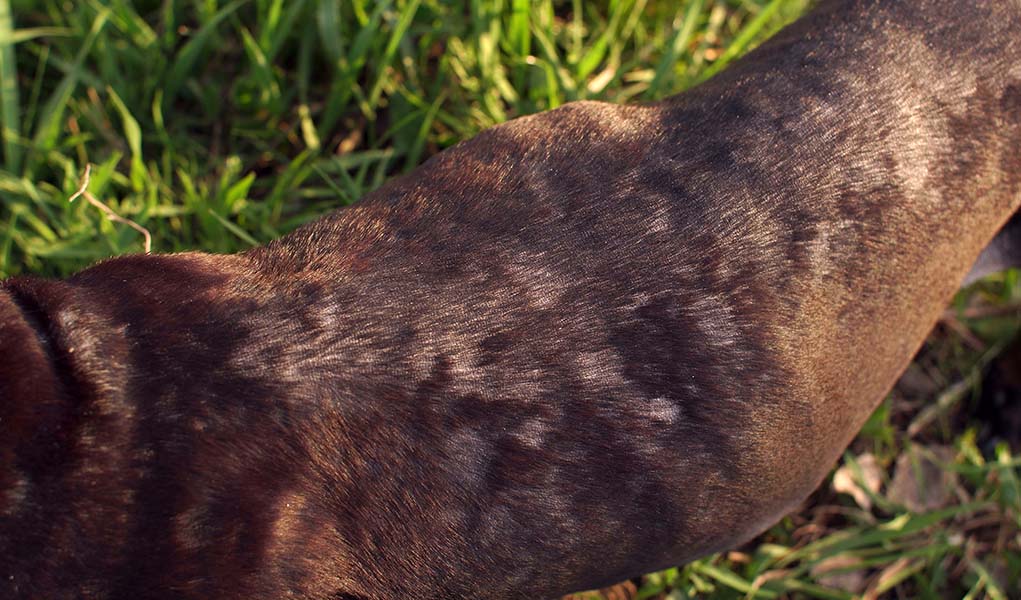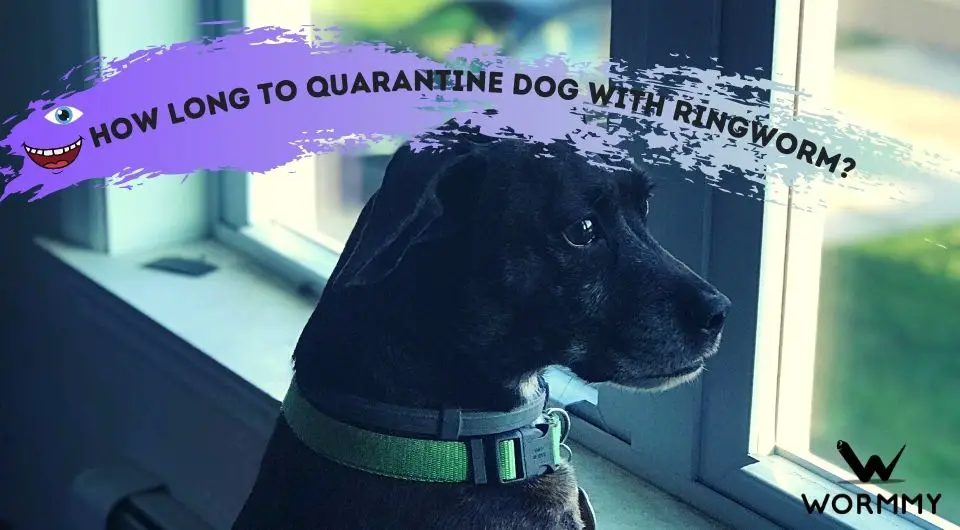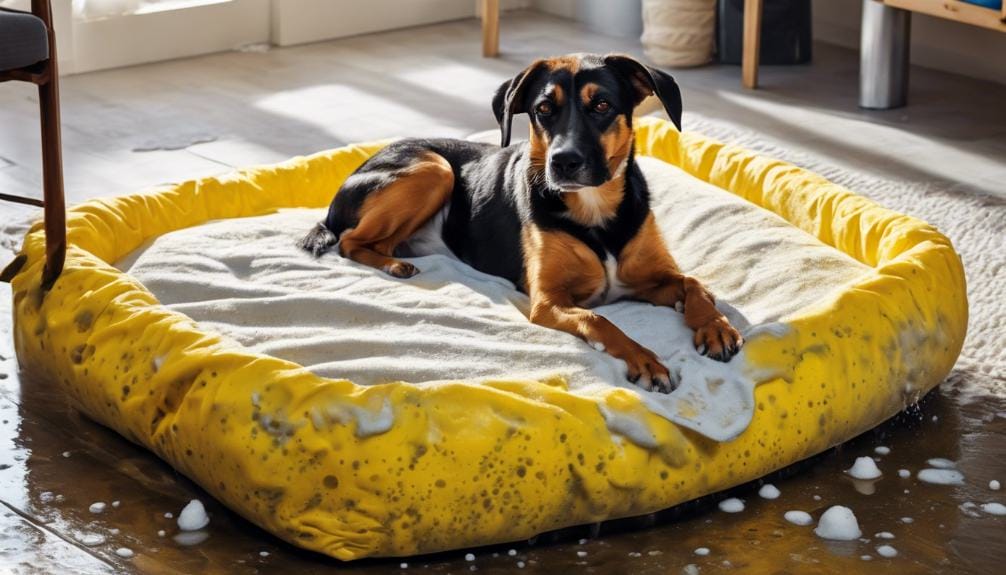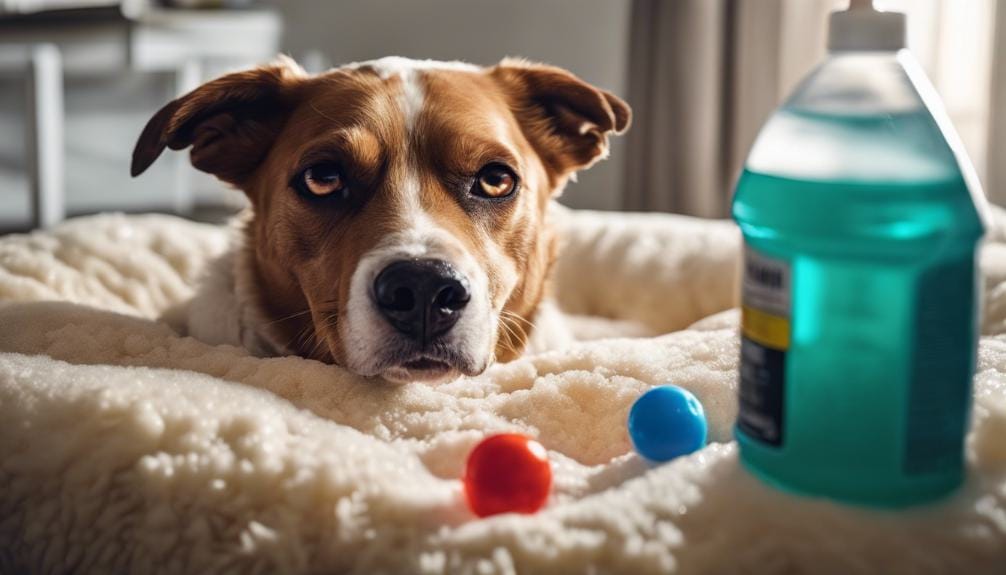If you suspect that your dog has ringworm, it’s essential to take immediate action to prevent the infection from spreading. But how long should you quarantine your furry friend to ensure the safety of both your dog and others? In this article, we will explore the recommended duration for isolating a dog with ringworm, providing you with the necessary guidance to protect your pet and curb the spread of this contagious fungal infection.

Understanding Ringworm in Dogs
Ringworm is a common fungal infection that can affect dogs of all ages and breeds. Contrary to its name, ringworm is not caused by a worm, but rather by a group of fungi known as dermatophytes. These fungi thrive in warm, humid environments and can be easily transmitted from one animal to another. In dogs, ringworm most commonly affects the skin, hair, and nails, causing a variety of symptoms that can range from mild to severe. It is important to understand the causes, symptoms, and treatment options for ringworm in order to effectively manage and prevent its spread.
Definition of Ringworm
Ringworm, also known as dermatophytosis, is a highly contagious fungal infection that affects the skin, hair, and nails of animals, including dogs. The name “ringworm” is derived from the characteristic ring-shaped rash that often appears on the skin of infected animals. Despite its name, ringworm is not caused by a worm, but rather by a group of fungi known as dermatophytes. These fungi feed on the keratin found in the outer layers of the skin, hair, and nails, leading to infection and subsequent symptoms.
How Ringworm Affects Dogs
When a dog becomes infected with ringworm, the fungi invade the outer layers of the skin, hair, and nails, leading to a variety of symptoms. The most common symptom of ringworm in dogs is the development of circular or irregularly-shaped patches of hair loss. These patches typically have a red, scaly border and may be accompanied by mild itching or irritation. In some cases, the affected areas may become crusty or flaky. In addition to hair loss, dogs with ringworm may also experience changes in the texture or appearance of their coat, such as brittleness or discoloration. It is important to note that ringworm can also infect humans, so proper precautions should be taken when handling an infected dog.
Symptoms of Ringworm in Dogs
The symptoms of ringworm in dogs can vary depending on the severity of the infection and the individual dog. Some common symptoms to look out for include:
- Circular or irregularly-shaped patches of hair loss
- Red, scaly border around affected areas
- Mild itching or irritation
- Crusty or flaky skin
- Changes in coat texture or color
- Brittle or broken hairs
- Nails that are brittle or discolored
If you notice any of these symptoms in your dog, it is important to consult with a veterinarian for a proper diagnosis and treatment plan.

Causes of Ringworm in Dogs
Ringworm in dogs can be caused by a variety of factors, including environmental factors, interactions with infected animals, and poor health and immunity issues.
Environmental Factors
Dermatophytes, the fungi that cause ringworm, thrive in warm, humid environments. Dogs that are exposed to these types of conditions are at a higher risk of developing a ringworm infection. Common sources of environmental contamination include contaminated bedding, grooming tools, and shared living spaces with infected animals.
Interactions with Infected Animals
Ringworm is highly contagious and can be easily transmitted from one animal to another through direct contact with an infected animal or through contact with contaminated objects or surfaces. Dogs that come into contact with infected animals, such as strays or animals in shelters, are at a higher risk of contracting ringworm.
Poor Health and Immunity Issues
Dogs with weakened immune systems, either due to underlying health conditions or medications that suppress the immune system, are more susceptible to ringworm infections. Poor nutrition and stress can also compromise a dog’s immune system, making them more susceptible to ringworm.
Diagnosis of Ringworm in Dogs
If you suspect that your dog has ringworm, it is important to consult with a veterinarian for a proper diagnosis. The diagnosis of ringworm in dogs typically involves a combination of veterinary consultation, physical examination, and laboratory tests and procedures.
Veterinary Consultation
During the veterinary consultation, the veterinarian will ask you questions about your dog’s medical history, symptoms, and any recent interactions with other animals. This information will help them determine the likelihood of ringworm and guide further diagnostic steps.
Physical Examination
During the physical examination, the veterinarian will examine your dog’s skin, hair, and nails for any visible signs of ringworm. They may use a special tool called a Wood’s lamp, which emits ultraviolet light, to help detect the presence of ringworm fungi. However, it is important to note that the Wood’s lamp may not always be effective in detecting all types of ringworm fungi.
Laboratory Tests and Procedures
To confirm the diagnosis of ringworm, the veterinarian may need to perform various laboratory tests and procedures. These may include:
- Fungal culture: A sample of hair or skin cells will be collected and sent to a laboratory for fungal culture. This test involves placing the sample in a special medium that promotes the growth of dermatophyte fungi. If the fungi grow, it confirms the diagnosis of ringworm.
- Microscopic examination: A sample of hair or skin cells may also be examined under a microscope to check for the presence of ringworm fungi. This test can provide quick results but may not be as accurate as a fungal culture.
- Polymerase chain reaction (PCR) testing: PCR testing is a more advanced diagnostic technique that can detect the presence of ringworm DNA in a sample. This test is highly accurate but may not be readily available at all veterinary clinics.
The combination of these diagnostic methods will help the veterinarian determine if your dog has ringworm and develop an appropriate treatment plan.

Treatment for Ringworm in Dogs
The treatment for ringworm in dogs usually involves a combination of medication options, topical treatments, and home care and hygiene.
Medication Options
Antifungal medications are commonly prescribed to treat ringworm in dogs. These medications can be administered orally or topically, depending on the severity and location of the infection. Oral medications are typically more effective for treating systemic or widespread infections, while topical medications are often used for localized infections. It is important to follow the veterinarian’s instructions regarding dosage and duration of medication.
Topical Treatments
In addition to medication, topical treatments can help alleviate the symptoms of ringworm and promote healing. These may include antifungal shampoos, creams, or ointments that are applied directly to the affected areas. Regular bathing with these products can help remove fungal spores from the skin and reduce the risk of further infection.
Home Care and Hygiene
Proper home care and hygiene practices are essential in the treatment of ringworm and in preventing its spread to other animals and humans. This includes regularly cleaning and disinfecting your dog’s bedding, grooming tools, and living areas. It is also important to wash your hands thoroughly after handling an infected dog and to avoid sharing personal items, such as towels or brushes, between infected and uninfected animals.
Dog Quarantine: Why it is Necessary?
Quarantining a dog with ringworm is an important step in preventing the spread of infection and ensuring proper treatment. By isolating the infected dog, you can minimize the risk of transmission to other animals and humans, provide appropriate treatment, and monitor the dog’s health condition.
Prevention of Spreading Infection
Ringworm is highly contagious and can spread easily from one animal to another. By quarantining an infected dog, you can prevent the spread of infection to other animals in your household or community.
Providing Appropriate Treatment
Quarantine allows you to provide focused and uninterrupted treatment to the infected dog. This includes administering medication, applying topical treatments, and practicing proper hygiene measures.
Monitoring Dog’s Health Condition
During the quarantine period, you can closely monitor the dog’s health condition and track the progress of treatment. This allows you to promptly identify any changes or complications and seek veterinary assistance if needed.

Duration of Quarantine Period for Ringworm
The duration of the quarantine period for ringworm can vary depending on various factors, including the severity of the infection, the effectiveness of treatment, and the individual dog’s response to treatment.
Factors Affecting Quarantine Duration
Some factors that can influence the duration of the quarantine period include:
- Severity of infection: Dogs with more severe or widespread ringworm infections may require a longer quarantine period to ensure complete recovery and minimize the risk of transmission.
- Treatment response: If the infected dog responds well to treatment and shows signs of improvement, the quarantine period may be shorter.
- Veterinary advice: It is important to consult with a veterinarian to determine the appropriate duration of quarantine based on the specific circumstances of the infection.
Typical Duration Recommendations
In general, a quarantine period of at least three to four weeks is often recommended for dogs with ringworm. This allows sufficient time for the infection to clear up and for the dog to be considered non-contagious.
Implementing Dog Quarantine at Home
Implementing a dog quarantine at home requires careful planning and attention to detail to ensure the safety and well-being of both the infected dog and other animals in the household.
Setting Up Quarantine Space
Designate a separate area of your home as the quarantine space for the infected dog. This area should be well-ventilated, easy to clean, and away from other animals. Provide comfortable bedding, food, water, and any necessary medications or topical treatments.
Feeding and Caring for Quarantined Dog
Ensure that the quarantined dog receives regular meals, fresh water, and any prescribed medications. Follow the veterinarian’s instructions regarding feeding, grooming, and general care.
Quality of Life During Quarantine
Although the infected dog is in quarantine, it is important to provide mental and physical stimulation to maintain their overall well-being. Provide toys, interactive play sessions, and social interaction with you or other family members while adhering to proper hygiene practices.

Preventing Spread of Ringworm from Dogs to Humans
Ringworm can be transmitted from infected dogs to humans, especially those with compromised immune systems, such as young children or individuals with pre-existing health conditions. To prevent the spread of ringworm from dogs to humans, it is important to implement appropriate hygiene measures.
Matching Human and Animal Hygiene Measures
Ensure that both humans and animals practice good hygiene habits, such as:
- Handwashing: Wash your hands thoroughly with soap and water after handling an infected dog or cleaning their living area.
- Avoid direct contact: Minimize direct contact with the infected dog, especially if you have any cuts, wounds, or compromised skin.
- Avoid sharing personal items: Do not share items, such as towels, bedding, or grooming tools, between infected and uninfected animals or between animals and humans.
When to Seek Medical Attention
If you develop any symptoms of ringworm, such as a circular rash, redness, itchiness, or changes in skin texture, it is important to seek medical attention. A healthcare professional can provide a proper diagnosis and recommend appropriate treatment options.
Caring for Other Pets During Quarantine
When one pet in the household is quarantined for ringworm, it is important to take specific safety measures to protect other pets from potential infection.
Safety Measures for Other Pets
To prevent the spread of ringworm to other pets, consider the following safety measures:
- Minimize contact: Keep the infected dog separated from other pets to minimize direct contact and the risk of transmission.
- Separate living areas: Provide each pet with their own bedding, food, and water bowls, and avoid sharing these items between infected and uninfected animals.
- Monitor for symptoms: Regularly check other pets for any signs of ringworm, such as hair loss, skin lesions, or changes in coat texture or color. If any symptoms are observed, consult with a veterinarian for proper diagnosis and treatment.
Post-Quarantine Care
Once the quarantine period for the infected dog is over, it is important to take certain steps to ensure a clean and safe environment and a smooth reintegration into the home and with other pets.
Cleaning and Sanitizing Your Home
Thoroughly clean and disinfect any areas, surfaces, bedding, or grooming tools that the infected dog came into contact with during the quarantine period. Use a veterinary-approved disinfectant that is effective against ringworm fungi and follow the instructions for use carefully.
Steps for Reintroducing Your Dog to Home and Other Pets
When reintroducing the dog to the home and other pets, consider the following steps:
- Gradual reintroduction: Allow the dog to explore the home and interact with other pets in a controlled manner. Supervise these interactions closely to ensure no signs of spread or reinfection.
- Monitor for symptoms: Continue monitoring the dog and other pets for any signs of ringworm after the quarantine period. If any symptoms reappear, consult with a veterinarian for further evaluation and treatment.
Routine Vet Check-ups after Quarantine
Schedule regular follow-up veterinary check-ups for the infected dog to monitor their overall health and ensure that the ringworm infection has been completely resolved. The veterinarian can provide guidance on any necessary ongoing treatment or preventive measures.
In conclusion, understanding ringworm in dogs is crucial for effective management, treatment, and prevention. By recognizing the causes, symptoms, and treatment options, pet owners can ensure the well-being of their dogs and reduce the risk of transmission to other animals and humans. Proper quarantine measures, along with appropriate hygiene practices, are essential in containing the spread of ringworm and promoting the recovery and health of infected dogs. By following veterinary advice and implementing recommended care and cleaning measures, pet owners can provide a safe and supportive environment for their affected pets, ultimately helping them overcome this common fungal infection.





Leave a Reply
You must be logged in to post a comment.